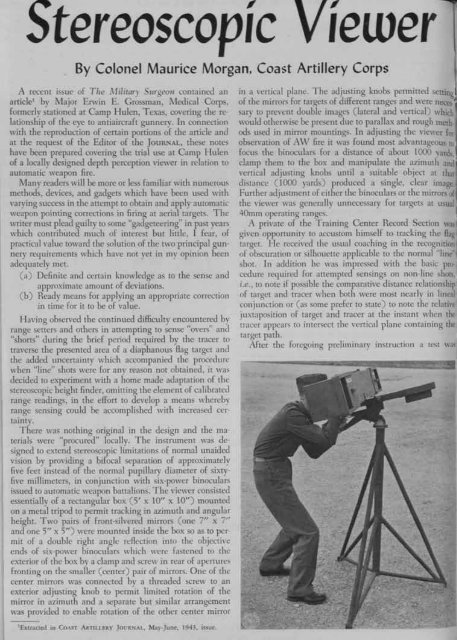July-August - Air Defense Artillery School
July-August - Air Defense Artillery School
July-August - Air Defense Artillery School
You also want an ePaper? Increase the reach of your titles
YUMPU automatically turns print PDFs into web optimized ePapers that Google loves.
Stereoscopic Viewer<br />
By Colonel Maurice Morgan, Coast <strong>Artillery</strong> Corps<br />
A recent issue of Tile J\lilitary Surgeoll contained an<br />
article' by l\lajor Erwin E. Grossman, i\ledical Corps.<br />
formerly stationed at Camp Hulen, Texas, covering the relationship<br />
of the eye to antiaircraft gunnery. In connection<br />
with the reproduction of certain portions of the article and<br />
at the request of the Editor of the JOURNAL, these notes<br />
have been prepared covering the trial use at Camp Hulen<br />
of a locally designed depth perception viewer in relation to<br />
automatic weapon fire.<br />
Manv readers will be more or less familiar with numerous<br />
method~, devices, and gadgets which have been used with<br />
varying success in the attempt to obtain and apply automatic<br />
weapon pointing corrections in firing at aerial targets. The<br />
writer must plead guilty to some "gadgeteering" in past years<br />
which contributed much of interest but little, I fear, of<br />
practical value toward the solution of the two principal gunnery<br />
requirements which have not yet in my opinion been<br />
adequately met.<br />
(a) Definite and certain knowledge as to the sense and<br />
approximate amount of deviations.<br />
(b) Ready means for applying an appropriate correction<br />
in time for it to be of value.<br />
Having observed the continued difficulty encountered by<br />
range setters and others in attempting to sense "overs" and<br />
"shorts" during the brief period required by the tracer to<br />
traverse the presented area of a diaphanous £lag target and<br />
the added uncertainty which accompanied the procedure<br />
when "line" shots were for any reason not obtained, it was<br />
decided to experiment with a home made adaptation of the<br />
stereoscopic height finder, omitting the element of calibrated<br />
range readings, in the effort to develop a means whereby<br />
range sensing could be accomplished with increased certainty.<br />
There was nothing original in the design and the materials<br />
were "procured" locally. The instrument was designed<br />
to extend stereoscopic limitations of normal unaided<br />
vision by providing a bifocal separation of approximately<br />
five feet instead of the normal pupillary diameter of sixtyfive<br />
millimeters, in conjunction with six-power binoculars<br />
issued to automatic weapon battalions. The viewer consisted<br />
essentially of a rectangular box (5' x 10" x 10") mounted<br />
on a metal tripod to permit tracking in azimuth and angular<br />
height. Two pairs of front-silvered mirrors (one 7" x 7"<br />
and one 5" x 5") were mounted inside the box so as to permit<br />
of a double right angle reRection into the objective<br />
ends of six-power binoculars which were fastened to the<br />
exterior of the box by a clamp and screw in rear of apertures<br />
fronting on the smaller (center) pair of mirrors. One of the<br />
center mirrors was connected bv a threaded screw to an<br />
exterior adjusting knob to pe~it limited rotation of the<br />
mirror in azimuth and a separate but similar arrangement<br />
was provided to enable rotation of the other center mirror<br />
'Extracted in COAST ARTILLERY JOUR:-:AL. Mar-June. 1943. issue.<br />
in a vertical plane. The adjusting knobs permitted settinD!<br />
of the mirrors for targets of different ranges and were neces~<br />
sary to prevent double images (lateral and vertical) which<br />
would otherwise be present due to parallax and rough meth.<br />
ods used in mirror mountings. In adjusting the viewer for<br />
observation of A\V fire it was found most advantageous to<br />
focus the binoculars for a distance of about 1000 yards<br />
clamp them to the box and manipulate the azimuth and<br />
vertical adjusting knobs until a suitable object at that<br />
distance (1000 yards) produced a single, clear image<br />
Further adjustment of either the binoculars or the mirrors of<br />
the viewer was generally unnecessary for targets at usual\<br />
40rnm operating ranges.<br />
A private of the Training Center Record Section \\asI<br />
given opportunity to accustom himself to tracking the £lag<br />
target. He received the usual coaching in the recognition<br />
of obscuration or silhouette applicable to the norma] "]ine<br />
shot. In addition he was impressed with the basic pro-j<br />
cedure required for attempted sensings on non-line shots,<br />
i.e., to note if possible the comparative distance relationship<br />
of target and tracer when both were most nearly in lineal<br />
conjunction or (as some prefer to state) to note the relatire<br />
juxtaposition of target and tracer at the instant when the<br />
tracer appears to intersect the vertical plane containing the<br />
target path.<br />
After the foregoing preliminary instruction a test \\a5
















